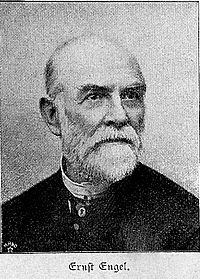Ernst Engel facts for kids
Quick facts for kids
Ernst Engel
|
|
|---|---|

Ernst Engel
|
|
| Born | 26 March 1821 |
| Died | 8 December 1896 (aged 75) Serkowitz (now part of Radebeul)
|
| Nationality | German |
| Known for | Engel curve and the Engel's law |
| Scientific career | |
| Fields | Statistician and economist |
Ernst Engel (born March 26, 1821 – died December 8, 1896) was an important German statistician and economist. He is best known for two big ideas: the Engel curve and Engel's law. These ideas help us understand how people spend their money.
Who Was Ernst Engel?
Ernst Engel was born in Dresden, Germany, in 1821. He went to school at the Freiberg University of Mining and Technology in Saxony. After finishing his studies, he traveled around Germany and France to learn more.
A Career in Statistics
After a time of big changes in Germany around 1848, Engel joined a special group in Saxony. This group was set up by the government to study how trade and work were connected.
In 1850, the government asked him to help organize the first ever German Industrial Exhibition in Leipzig. This was a big show where new inventions and products were displayed. Engel did such a great job that in 1854, he was asked to work for the government. He became the head of a brand new department that collected and studied numbers, called the statistical department.
He left this job in 1858. After that, he started the first-ever Mortgage Insurance Society in Dresden. This was a new type of insurance company that helped people get loans to buy homes. Because of his success, he was asked to come to Berlin in 1860. There, he became the director of the statistical department for all of Prussia.
In this new role, he became very famous around the world for his work. He was given a high honor called Geheimer Regierungsrat. Engel retired in 1882. He then lived in Serkowitz, which is now part of Radebeul, near Dresden. He passed away there in 1896. His studies on how working-class people lived were very important and widely noticed.
Important Ideas and Writings
Ernst Engel wrote many books and articles about his work. Most of his statistical papers were published in special journals that he started himself. These included Preuss. Statistik (started in 1861) and Zeitschrift des Königlichen Preußischen Statistischen Bureaus. He also started Zeitschrift des Statistischen Bureaus des Königreichs Sachsen.
Some of his well-known books include:
- Die Methoden der Volkszählung (which means "Census methods," published in 1861). This book was about how to count people in a country.
- Die Volkszählungen, ihre Stellung zur Wissenschaft und ihre Aufgabe in der Geschichte ("Censuses, their place in science and role in history," published in 1862). This looked at why counting people was important for science and history.
- Land und Leute des Preussischen Staates ("The Prussian land and people," published in 1863). This book described the land and people of Prussia.
- Das Zeitalter des Dampfes ("The era of steam," published in 1881). This book talked about the time when steam power became very important.
See also
 In Spanish: Ernst Engel para niños
In Spanish: Ernst Engel para niños

